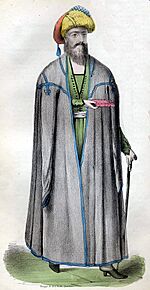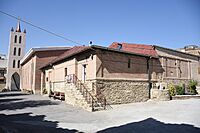Assyrian Church of the East facts for kids
Quick facts for kids 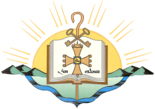 Holy Apostolic Catholic Assyrian Church of the East |
|
|---|---|
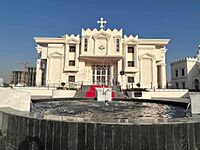
The main office of the Assyrian Church of the East in the Kurdistan Region, Iraq
|
|
| Abbreviation | ACOE |
| Classification | Christian |
| Orientation | Syriac |
| Theology | East Syriac theology |
| Catholicos-Patriarch | Mar Awa III |
| Region | Central Middle East, India; diaspora |
| Language | Syriac, Aramaic |
| Liturgy | East Syriac Rite |
| Headquarters | Ankawa, Erbil, Kurdistan Region, Iraq |
| Absorbed | Chaldean Syrian Church (1907) |
| Separations | Chaldean Catholic Church (1830), Ancient Church of the East (1968) |
| Members | 400,000+ (2021) |
The Assyrian Church of the East is an ancient Christian church that began with the Assyrian people. Its official name is the Holy Apostolic Catholic Assyrian Church of the East. This church follows the traditions of the historic Church of the East.
The church belongs to the eastern branch of Syriac Christianity. This means its services and prayers are in the Syriac language, which is a form of the ancient Aramaic language. The church's main office is in the city of Erbil, Iraq. Its original homeland included parts of modern-day Iraq, Turkey, Syria, and Iran.
The leader of the church is called the Catholicos-Patriarch. As of September 2021, the leader is Mar Awa III. The Assyrian Church of the East is independent and not in communion with the Catholic, Oriental Orthodox, or Eastern Orthodox churches. However, it has a friendly relationship with the Chaldean Catholic Church.
Contents
History of the Church
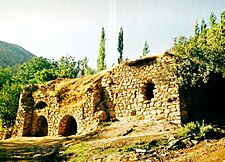
The Assyrian Church of the East sees itself as a continuation of the Church of the East. This church was started by the Assyrian people in the first century A.D. They believe it was founded by the apostles Thomas, Addai, and Bartholomew.
The church's modern form comes from a series of splits and mergers that happened between the 16th and 19th centuries. During this time, a major issue was whether to unite with the Catholic Church in Rome. The groups that joined the Catholic Church became the Chaldean Catholic Church. The groups that kept their old traditions became the Assyrian Church of the East.
Splits and New Branches
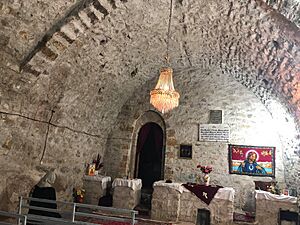
In the 1500s, some members of the church disagreed with their leader, Patriarch Shemon VII Ishoyahb. One major issue was that the position of patriarch was being passed down within the same family. A group that wanted to unite with the Catholic Church chose a new leader, Yohannan Sulaqa.
In 1553, Sulaqa traveled to Rome and was named a patriarch by the Pope. This created a new branch of the church that was connected to the Catholic Church. This new branch was called the Shimun line because its leaders took the name Shimun.
Meanwhile, the original branch, known as the Eliya line, remained independent. For many years, these two branches existed side-by-side. The Eliya line stayed in its traditional home near Alqosh, while the Shimun line moved around.
Over time, the Shimun line grew distant from the Catholic Church. In 1672, it officially broke all ties with Rome and became independent again. This meant there were now two separate, traditional Assyrian church branches: the senior Eliya line and the junior Shimun line.
Coming Together as One Church
In 1804, the leader of the Eliya line died, and no new leader was chosen. This allowed the leader of the Shimun line, Patriarch Shimun XVI Yohannan, to become the single leader for both traditional branches. The reunited church became known as the Assyrian Church of the East.
The church's leaders, who were based in Qochanis (in modern-day Turkey), faced many challenges. In the 1840s, local warlords attacked Christian villages, causing great harm to the community. The patriarch had to flee for safety.
The 20th Century and a New Home

The early 20th century was a very difficult time for the Assyrian people. During World War I, the Assyrian genocide occurred. The church was based in the Hakkari mountains of Turkey. Fearing the Assyrians wanted independence, Ottoman forces and their allies attacked them.
Assyrians of all Christian denominations fought for their survival. But they were eventually left without allies and supplies. Many were killed, and the survivors had to flee their homes. They traveled through Iran and settled in what is now Iraq, seeking protection.
A Leader in Exile
After the war, the new patriarch, Shimun XXI Eshai, tried to create an independent state for the Assyrian people. After a massacre of Assyrians in 1933 by the Iraqi Army, he was forced to leave the country. He eventually moved to Chicago in the United States in 1940.
Patriarch Shimun XXI Eshai worked to reorganize the church for the many Assyrians living outside the Middle East. In 1964, he made several changes, like adopting the modern Gregorian calendar. These changes caused a split, and a new group called the Ancient Church of the East was formed in 1968.
Modern Patriarchs

After Patriarch Shimun XXI Eshai was assassinated in 1975, a new leader, Dinkha IV, was chosen in 1976. He ended the tradition of passing the leadership down through one family. He first led the church from Tehran, Iran, but later moved the main office (the Patriarchal See) to Chicago.
Patriarch Dinkha IV worked to care for Assyrians around the world and to build better relationships with other churches. He died in 2015.
He was followed by Gewargis III, who was chosen in 2015. One of his goals was to move the Patriarchal See from Chicago back to the church's homeland in Erbil, Iraq.
In 2021, Mar Gewargis III stepped down. The church's Holy Synod then elected Mar Awa Royel as the 122nd Catholicos-Patriarch. He is the current leader of the Assyrian Church of the East.
Beliefs of the Church
| Part of the series on Eastern Christianity |
|
 Eastern Christianity Portal |
|
|
History |
|
|
Traditions |
|
|
Liturgy and Worship |
|
|
Theology |
|
The Assyrian Church of the East follows the Nicene Creed, a statement of faith shared by many Christians. They believe in the Trinity—that God is one being in three persons: the Father, the Son (Jesus Christ), and the Holy Spirit.
Understanding of Christ
The church has a unique understanding of Jesus Christ, which comes from the ancient theological school of Antioch. This tradition emphasizes both the humanity and the divinity of Jesus.
Because of its specific beliefs, the church did not accept the decisions of the Council of Ephesus in 431 and the Council of Chalcedon in 451. For this reason, its teachings have sometimes been called "Nestorian." However, the church itself does not use this label and states that its beliefs are orthodox.
In 1994, the church signed a "Common Christological Declaration" with the Catholic Church. This was a major step in showing that their differences in language did not mean they had completely different beliefs about Jesus.
Church Services and Art
The church uses the East Syriac Rite for its services. This is a very old style of worship. The main language used is Syriac, a dialect of Aramaic, the language Jesus likely spoke.
Icons and Church Buildings
Today, the Assyrian Church of the East does not use icons (religious paintings) in its churches. The inside of their church buildings are usually simple. In their homes, members often hang a plain Christian cross on the eastern wall of a room.
Historically, the church did use images. Old manuscripts, like a 13th-century Gospel book, show illustrations of Jesus and angels. The use of images declined over time, partly because of the influence of Islam, which forbids pictures of prophets.
How the Church is Organized
The church is led by the Catholicos-Patriarch. Below him are bishops who lead different regions, called dioceses. Priests and deacons serve in local parishes.
Because many Assyrians have moved from the Middle East, the church now has dioceses all over the world. There are communities in North America, Europe, and Australia.
The largest diocese of the church is the Chaldean Syrian Church in India. It has a long history connected to the ancient Church of the East.
The church has about 400,000 members worldwide. Most live in Iraq, Iran, Syria, the United States, and other countries with large Assyrian communities.
See also
 In Spanish: Iglesia asiria del Oriente para niños
In Spanish: Iglesia asiria del Oriente para niños
- Chaldean Syrian Church in India
- Church of the East in China
- Common Christological Declaration Between the Catholic Church and the Assyrian Church of the East
- List of patriarchs of the East
- List of Assyrian settlements



